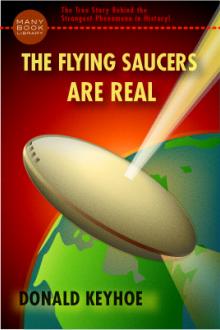The Flying Saucers are Real by Donald Keyhoe (best classic novels .TXT) 📕

- Author: Donald Keyhoe
- Performer: -
Book online «The Flying Saucers are Real by Donald Keyhoe (best classic novels .TXT) 📕». Author Donald Keyhoe
“I know some of those reports aren’t authentic,” he admitted. “But if you accept even one report of a flying disk or rocket-shaped object before the twentieth century, then you have to accept the basic idea. In the last forty years, you might blame the reports on planes and dirigibles. But there was no propelled aircraft until 1903. {p. 109} Either all those early sightings were wrong, or some kind of fast aerial machine has been flying periodically over the earth for at least two centuries.
I told him I was pretty well convinced, but that True faced a problem. There was some conflicting evidence, and part of it seemed linked with guided missiles. I felt sure we could prove the space-travel answer, but we had to stay clear of discussing any weapons that were still a secret.
“I can’t believe that guided missiles are the answer to the Godman Field saucer and the Chiles-Whitted case, or this business at Fargo. But we’re got to be absolutely sure before we print anything.”
“Well, let’s analyze it,” said Redell. “Let’s see if all the saucers could be explained as something launched from the earth.”
He reached for a pad and a pencil.
“First, let’s take your rotating disk. That would be a lot simpler to build than the stationary disk with variable jet nozzles. With a disk rotated at high speed you get a tremendous lift, whether it’s slotted or cambered, as long as there’s enough air to work on.”
“The helicopter principle,” I said.
Redell nodded. “The most practical propulsion would be with two or more jets out on the rim, to spin your rotating section. But to get up enough speed for the jets to be efficient, you’d have to whirl the disk mechanically before the take-off. Here’s one way. You could have a square hole in the center; then the disk launching device would have a square shaft, rotated by an engine or a motor. As the speed built up, the cambered disk would ride up the shaft and free itself, rising vertically, with the jets taking over the job of whirling the cambered section.
“The lift would be terrific, far more than any normal aircraft. I don’t believe any human being could take the G’s involved in a maximum power climb; they’d have to use remote control. When it got to the desired altitude, your disk could be flown in any direction by tilting it that way. The forward component from that tremendous
{p. 110}
lift would result in a very high speed. The disk could also hover, and descend vertically.”
“What about maneuvering?” I asked, thinking of Gorman’s experience.
“It could turn faster than any pilot could stand,” said Redell. “Of course, a pilot’s cockpit could be built into a large disk; but there’d have to be some way of holding down the speed, to avoid too many G’s in tight maneuvers.”
“Most of the disks don’t make any noise,” I said. “At least, that’s the general report. You’d hear ordinary jets for miles.”
“Right, and here’s another angle. Ram jets take a lot of fuel. Even with some highly efficient new jet, I can’t see the long ranges reported. Some of these saucers have been seen all over the world. No matter which hemisphere they were launched from, they’d need an eight-thousand-mile range, at least, to explain all of the sightings. The only apparent answer would be some new kind of power, probably atomic. We certainly didn’t have atomic engines for aircraft in 1947, when the first disks were seen here. And we don’t have them now, though we’re working on it. Even if we had such an engine, it wouldn’t be tiny enough to power the small disks.”
“Anyway,” I said, “we’d hardly be flying them all over everywhere. The cost would be enormous, and there’d always be a danger of somebody getting the secret if a disk landed.”
“Plus the risk of injuring people by radiation. just imagine an atomic-powered disk dropping into a city. The whole idea’s ridiculous.”
“That seems to rule out the guided-missile answer,” I began. But Redell shook his head.
“Disk-shaped missiles are quite feasible. I’m talking about range, speed, and performance. Imagine for a moment that we have disk-type missiles using the latest jet or rocket propulsion—either piloted or remote-controlled. The question is, could such disks fit specific sightings like the one at Godman Field and the case at Fargo?”
Redell paused as if some new thought had struck him.
“Wait a minute, here’s an even better test. I happen to
{p. 111}
know about this case personally. Marvin Miles—he’s an aviation writer in Los Angeles—was down at White Sands Proving Ground some time ago. He talked with a Navy rocket expert who was in charge of naval guided-missile projects. This Navy man—he’s a commander in the regular service—told Miles they’d seen four saucers down in that area.”
“You’re sure he wasn’t kidding Miles?” I said. Then I remembered Purdy’s tip about a White Sands case.
“I told you I checked on this myself,” Redell said, a little annoyed. “After Miles told me about it, I asked an engineer who’d been down there if it was true. He gave me the same story, figures and all. The first saucer was tracked by White Sands observers with a theodolite. Then they worked out its performance with ballistics formulas.”
Redell looked at me grimly.
“The thing was about fifty miles up. And it was making over fifteen thousand miles an hour!”
One of the witnesses, said Redell, was a well-known scientist from the General Mills aeronautical research laboratory in Minneapolis, which was working with the Navy. (A few days later, I verified this fact and the basic details of Redell’s account. But it was not until early in January 1950 that I finally identified the officer as Commander Robert B. McLaughlin and got his dramatic story.)
“Here are two more items Miles told me,” Redell went on. “This Navy expert said the saucer actually looked elliptical, or egg-shaped. And while it was being tracked it suddenly made a steep climb—so steep no human being could have lived through it.”
“One thing is certain,” I said. “That fifty-mile altitude knocks out the rotating disk. Up in that thin air it wouldn’t have any lift.”
“Right,” said Redell. “And the variable jet type would require an enormous amount of fuel. Regardless, those G’s mean it couldn’t have had any pilot born on this earth.”
According to Marvin Miles, this White Sands saucer had been over a hundred feet long. (Later, Commander
{p. 112}
McLaughlin stated that it was 105 feet.) If this were an American device, then it meant that we had already licked many of the problems on which the Earth Satellite Vehicle designers were supposed to be just starting. Their statements, then, would have to be false—part of an elaborate cover-up.
“If we had such an advanced design,” said Redell, “and I just don’t believe it possible—would we gamble on a remote-control system? No such system is perfect. Suppose it went wrong. At that speed, over fifteen thousand miles an hour, your precious missile or strato ship could be halfway around the globe in about forty-five minutes. That is, if the fuel held out. Before you could regain control, you might lose it in the sea. Or it might come down behind the Iron Curtain. Even if it were I smashed to bits, it would tip off the Soviets. They might claim it was a guided-missile attack. Almost anything could hap pen.”
“It could have a time bomb in it,” I suggested. “if it got off course or out of control, it would blow itself up.”
Redell emphatically shook his head. “I’ve heard that idea before, but it won’t hold up. What if your ship’s controls went haywire and the thing blew up over a crowded city? Imagine the panic, even if no actual damage was done. No, sir—nobody in his right mind is going to let a huge ship like that go barging around unpiloted. It would be criminal negligence.
“If the White Sands calculations were correct, then this particular saucer was no earth-made device. Perhaps in coming years, we could produce such a ship, with atomic power to drive it. But not now.”
Redell went over several other cases.
“Take the Godman Field saucer. At one time, it was seen at places one hundred and seventy-five miles apart, as you know. Even to have been seen at all from both places, it would. have to have been huge—much larger than two hundred and fifty feet in diameter. The human eye wouldn’t resolve an object that size, at such a distance and height.”
It was an odd thing; I had, gone over the Mantell case
{p. 113}
a dozen times. I knew the object was huge. But I had never tried to figure out the object’s exact size.
“How big do you think it was?” I asked quickly. This could be the key I had tried to find.
“I haven’t worked it out,” said Redell. “But I can give you a rough idea. The human eye can’t resolve any object that subtends less than three minutes of arc. For instance, a plane with a hundred-foot wing span would only be a speck twenty miles away, if you saw it at all.”
“But this thing was seen clearly eighty-seven miles away—or even more, if it wasn’t midway between the two cities. Why, it would have to be a thousand feet in diameter.”
“Even larger.” Redell was silent a moment. “What was the word Mantell used—‘tremendous’?” I tried to visualize the thing, but my mind balked. One thing was certain now. It was utterly impossible that any nation on earth could have built such an enormous airborne machine. just to think of the force required to hold it in the sky was enough to stagger any engineer. We were years away—perhaps centuries—from any such possibility.
As if he had read my thoughts, Redell said soberly, “There’s no other possible answer. It was a huge space ship—perhaps the largest ever to come into our atmosphere.”
It was clear now why such desperate efforts had been made to explain away the object Mantell had chased.
“What about that Eastern Airlines sighting?” I asked.
“Well, first,” said Redell, “it wasn’t any remote-control guided missile. I’ll say it again; it would be sheer insanity. Suppose that thing had crashed in Macon. At that speed it could have plowed its way for blocks, right through the buildings. It could have killed hundreds of people, burned the heart out of the city.
“If it was a missile, or some hush-hush experimental job, then it was piloted. But they don’t test a job like that on any commercial airways. And they don’t fool around at five thousand feet where people will see the thing streaking by and call the newspapers.
“To power a hundred-foot wingless ship, especially at those speeds, would take enormous force. Not as much
{p. 114}
as a V-two rocket, but tremendous power. The fuel load would be terrific. Certainly, the pilot wouldn’t be circling around Georgia and Alabama for an hour, buzzing airliners. I’ll stake everything that we couldn’t duplicate that space ship’s performance for less than fifty million dollars. It would take something brand-new in jets.”
Redell paused. He looked at me grimly. “And the way I’d have to soup it up, it would be a damned dangerous ship to fly. No pilot would deliberately fly it that low. He’d stay up where he’d have a chance to bail out.”
I told him what I had heard about the blueprints the Air Force was said to have rushed.
“Of course they were worried,” said Redell. “And probably they still are. But I don’t think they need be; so far, there’s been nothing menacing about these space ships.”
When I got him back to the Gorman





Comments (0)